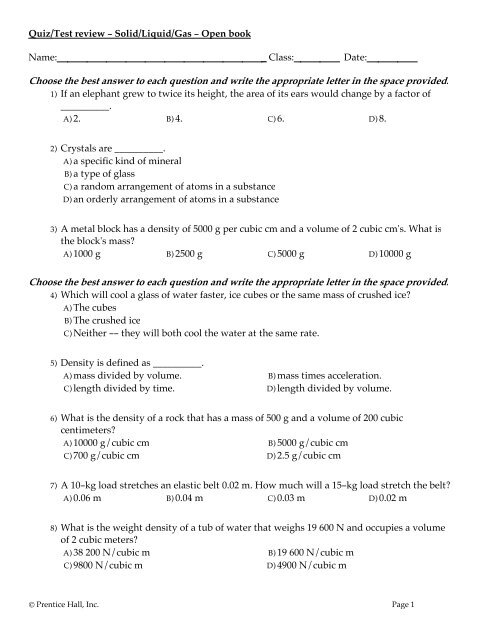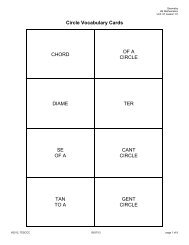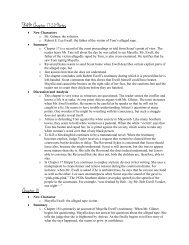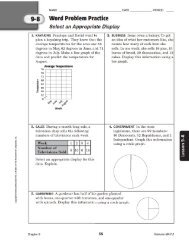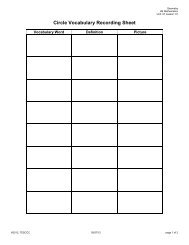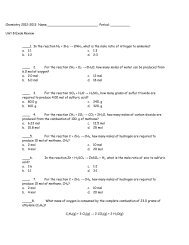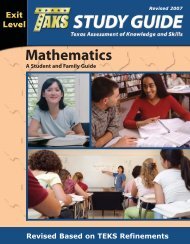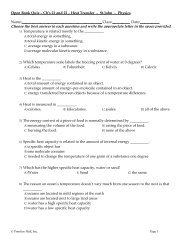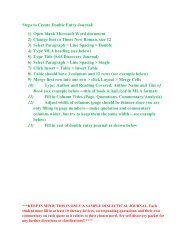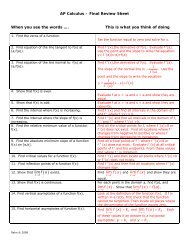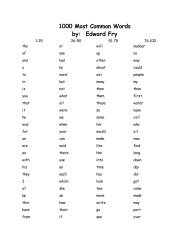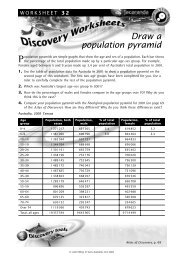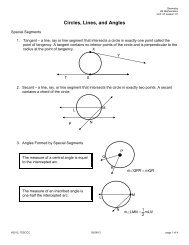Choose the best answer to each question and write the appropriate ...
Choose the best answer to each question and write the appropriate ...
Choose the best answer to each question and write the appropriate ...
Create successful ePaper yourself
Turn your PDF publications into a flip-book with our unique Google optimized e-Paper software.
Quiz/Test review - Solid/Liquid/Gas - Open book<br />
Name: _ Class: Date:<br />
<strong>Choose</strong> <strong>the</strong> <strong>best</strong> <strong>answer</strong> <strong>to</strong> <strong>each</strong> <strong>question</strong> <strong>and</strong> <strong>write</strong> <strong>the</strong> <strong>appropriate</strong> letter in <strong>the</strong> space provided.<br />
1) If an elephant grew <strong>to</strong> twice its height, <strong>the</strong> area of its ears would change by a fac<strong>to</strong>r of<br />
__________.<br />
A) 2. B) 4. C) 6. D) 8.<br />
2) Crystals are __________.<br />
A) a specific kind of mineral<br />
B) a type of glass<br />
C) a r<strong>and</strong>om arrangement of a<strong>to</strong>ms in a substance<br />
D) an orderly arrangement of a<strong>to</strong>ms in a substance<br />
3) A metal block has a density of 5000 g per cubic cm <strong>and</strong> a volume of 2 cubic cm's. What is<br />
<strong>the</strong> block's mass?<br />
A) 1000 g B) 2500 g C) 5000 g D) 10000 g<br />
<strong>Choose</strong> <strong>the</strong> <strong>best</strong> <strong>answer</strong> <strong>to</strong> <strong>each</strong> <strong>question</strong> <strong>and</strong> <strong>write</strong> <strong>the</strong> <strong>appropriate</strong> letter in <strong>the</strong> space provided.<br />
4) Which will cool a glass of water faster, ice cubes or <strong>the</strong> same mass of crushed ice?<br />
A) The cubes<br />
B) The crushed ice<br />
C) Nei<strong>the</strong>r -- <strong>the</strong>y will both cool <strong>the</strong> water at <strong>the</strong> same rate.<br />
5) Density is defined as __________.<br />
A) mass divided by volume. B) mass times acceleration.<br />
C) length divided by time. D) length divided by volume.<br />
6) What is <strong>the</strong> density of a rock that has a mass of 500 g <strong>and</strong> a volume of 200 cubic<br />
centimeters?<br />
A) 10000 g/cubic cm B) 5000 g/cubic cm<br />
C) 700 g/cubic cm D) 2.5 g/cubic cm<br />
7) A 10-kg load stretches an elastic belt 0.02 m. How much will a 15-kg load stretch <strong>the</strong> belt?<br />
A) 0.06 m B) 0.04 m C) 0.03 m D) 0.02 m<br />
8) What is <strong>the</strong> weight density of a tub of water that weighs 19 600 N <strong>and</strong> occupies a volume<br />
of 2 cubic meters?<br />
A) 38 200 N/cubic m B) 19 600 N/cubic m<br />
C) 9800 N/cubic m D) 4900 N/cubic m<br />
© Prentice Hall, Inc. Page 1
<strong>Choose</strong> <strong>the</strong> <strong>best</strong> <strong>answer</strong> <strong>to</strong> <strong>each</strong> <strong>question</strong> <strong>and</strong> <strong>write</strong> <strong>the</strong> <strong>appropriate</strong> letter in <strong>the</strong> space provided.<br />
9) Which geometrical shape has <strong>the</strong> least surface area for a given volume?<br />
A) cube B) pyramid C) cylinder D) sphere<br />
10) If <strong>the</strong> volume of an object were <strong>to</strong> double while its mass stayed <strong>the</strong> same, its density<br />
would __________.<br />
A) halve B) double C) stay <strong>the</strong> same<br />
11) Which has <strong>the</strong> greater density, 5 kg of silver or 10 kg of steel?<br />
A) The silver<br />
B) The steel<br />
C) They both have <strong>the</strong> same density<br />
<strong>Choose</strong> <strong>the</strong> <strong>best</strong> <strong>answer</strong> <strong>to</strong> <strong>each</strong> <strong>question</strong> <strong>and</strong> <strong>write</strong> <strong>the</strong> <strong>appropriate</strong> letter in <strong>the</strong> space provided.<br />
12) The reason falling heavy objects hit <strong>the</strong> ground faster than falling light objects is that<br />
heavy objects (remember, Gravity pulls ALL objects at 9.8 m/s2)__________.<br />
A) accelerate faster than light objects.<br />
B) have more air resistance.<br />
C) have a smaller ratio of surface area <strong>to</strong> weight.<br />
D) all of <strong>the</strong> above<br />
13) The reason an iron ship doesn't sink is that __________.<br />
A) iron is less dense than water<br />
B) <strong>the</strong> iron displaces more water than it would if it were in a solid block<br />
C) air inside decreases it's weight<br />
D) Nonsense -- an iron ship will always sink<br />
14) There is a legend of a Dutch boy who bravely held back <strong>the</strong> Atlantic Ocean by plugging a<br />
leak near <strong>the</strong> <strong>to</strong>p of a dike with his finger until help arrived. Which of <strong>the</strong> following is<br />
most likely?<br />
A) This is impossible because of <strong>the</strong> large size of <strong>the</strong> Atlantic Ocean.<br />
B) The force on his finger would have been huge, but <strong>the</strong> pressure very small.<br />
C) The force on his finger would have been less than 1 N.<br />
D) Both <strong>the</strong> force <strong>and</strong> pressure on his finger would have been very large.<br />
15) Suppose a s<strong>to</strong>ne weighs 3 N in <strong>the</strong> air, but in water it weighs only 2 N. What is <strong>the</strong><br />
buoyant force acting on <strong>the</strong> s<strong>to</strong>ne?<br />
A) 5 N B) 4 N C) 3 N D) 2 N E) 1 N<br />
© Prentice Hall, Inc. Page 2
<strong>Choose</strong> <strong>the</strong> <strong>best</strong> <strong>answer</strong> <strong>to</strong> <strong>each</strong> <strong>question</strong> <strong>and</strong> <strong>write</strong> <strong>the</strong> <strong>appropriate</strong> letter in <strong>the</strong> space provided.<br />
16) If an object has a density equal <strong>to</strong> <strong>the</strong> density of water, it will __________.<br />
A) float B) sink C) nei<strong>the</strong>r float nor sink<br />
17) If <strong>the</strong> part of an iceberg that extends above <strong>the</strong> water were removed, <strong>the</strong> __________.<br />
A) iceberg would sink.<br />
B) iceberg would rise higher in <strong>the</strong> water.<br />
C) density of <strong>the</strong> iceberg would change.<br />
D) pressure on <strong>the</strong> bot<strong>to</strong>m of <strong>the</strong> iceberg would increase.<br />
18) When first put in water, a plastic <strong>to</strong>y boat will sink until __________.<br />
A) it displaces a volume of water equal <strong>to</strong> its own volume<br />
B) it displaces a weight of water equal <strong>to</strong> its own weight<br />
C) <strong>the</strong> water density equals <strong>the</strong> density of <strong>the</strong> boat<br />
D) <strong>the</strong> buoyant force equals <strong>the</strong> volume of <strong>the</strong> boat<br />
19) Pressure in a liquid depends on <strong>the</strong> __________.<br />
A) density of <strong>the</strong> liquid.<br />
B) volume of <strong>the</strong> liquid.<br />
C) mass of <strong>the</strong> liquid.<br />
D) depth of <strong>the</strong> measuring point.<br />
E) both A <strong>and</strong> D<br />
20) If an object has a density greater than <strong>the</strong> density of water, it will __________.<br />
A) float B) sink C) nei<strong>the</strong>r float nor sink<br />
21) When a boat sails from fresh water <strong>to</strong> salt water, <strong>the</strong> boat will float __________.<br />
A) lower in <strong>the</strong> salt water B) higher in <strong>the</strong> salt water C) at <strong>the</strong> same level<br />
22) When you float in salt water compared <strong>to</strong> floating in fresh water, <strong>the</strong> buoyant force that<br />
supports you is __________.<br />
A) greater B) less C) <strong>the</strong> same<br />
23) An egg is placed at <strong>the</strong> bot<strong>to</strong>m of a bowl filled with water. Salt is slowly added <strong>to</strong> <strong>the</strong><br />
water until <strong>the</strong> egg rises <strong>and</strong> floats. From this experiment, one can conclude that<br />
__________.<br />
A) calcium in <strong>the</strong> eggshell is repelled by sodium chloride.<br />
B) <strong>the</strong> density of salt water exceeds <strong>the</strong> density of egg.<br />
C) buoyant forces do not always act upward.<br />
D) salt sinks <strong>to</strong> <strong>the</strong> bot<strong>to</strong>m.<br />
© Prentice Hall, Inc. Page 3
24) Floating Freda, who can just barely float in fresh water, has a mass of 100 kg. Her volume<br />
is <strong>the</strong>refore about __________.<br />
A) 50 liters. B) 100 liters.<br />
C) 220 liters. D) none of <strong>the</strong> above<br />
25) An industrial container holds 200 N of water. The area of <strong>the</strong> inside bot<strong>to</strong>m of <strong>the</strong><br />
container is 2 square meters. What pressure does <strong>the</strong> water exert on <strong>the</strong> bot<strong>to</strong>m of <strong>the</strong><br />
container?<br />
A) 100 N per square meter B) 200 N per square meter<br />
C) 400 N per square meter D) 800 N per square meter<br />
<strong>Choose</strong> <strong>the</strong> <strong>best</strong> <strong>answer</strong> <strong>to</strong> <strong>each</strong> <strong>question</strong> <strong>and</strong> <strong>write</strong> <strong>the</strong> <strong>appropriate</strong> letter in <strong>the</strong> space provided.<br />
26) The pressure at <strong>the</strong> bot<strong>to</strong>m of a jug filled with water does NOT depend on <strong>the</strong><br />
__________.<br />
A) acceleration due <strong>to</strong> gravity B) density of water<br />
C) depth of <strong>the</strong> liquid D) surface area of <strong>the</strong> water<br />
27) Where is <strong>the</strong> pressure greater, one meter beneath <strong>the</strong> surface of Lake Michigan or one<br />
meter beneath <strong>the</strong> surface of a swimming pond?<br />
A) In Lake Michigan B) In <strong>the</strong> pond C) The same in both places<br />
28) When an ice cube in a glass of water melts, <strong>the</strong> water level __________.<br />
A) rises B) falls C) remains <strong>the</strong> same<br />
29) Two equal-sized buckets are filled <strong>to</strong> <strong>the</strong> <strong>to</strong>p with water. One of <strong>the</strong> buckets has a piece<br />
of wood floating in it, making its <strong>to</strong>tal weight __________.<br />
A) less than <strong>the</strong> weight of <strong>the</strong> o<strong>the</strong>r bucket<br />
B) equal <strong>to</strong> <strong>the</strong> weight of <strong>the</strong> o<strong>the</strong>r bucket<br />
C) more than <strong>the</strong> weight of <strong>the</strong> o<strong>the</strong>r bucket<br />
30) If you are st<strong>and</strong>ing on <strong>the</strong> moon <strong>and</strong> release a balloon filled with helium gas, <strong>the</strong> balloon<br />
will __________.<br />
A) rise B) fall C) nei<strong>the</strong>r rise nor fall<br />
31) The reason water can be pumped out of a well using an old-fashioned farm-type pump is<br />
that <strong>the</strong> __________.<br />
A) water level is very close <strong>to</strong> <strong>the</strong> pump.<br />
B) pump scoops up <strong>the</strong> water <strong>and</strong> lifts it <strong>to</strong> <strong>the</strong> <strong>to</strong>p.<br />
C) pump sucks <strong>the</strong> water up from <strong>the</strong> well.<br />
D) water is pushed <strong>to</strong> <strong>the</strong> surface by <strong>the</strong> atmosphere.<br />
© Prentice Hall, Inc. Page 4
32) An umbrella tends <strong>to</strong> move upward on a windy day because __________.<br />
A) air gets trapped under <strong>the</strong> umbrella <strong>and</strong> pushes it up.<br />
B) buoyancy increases with increasing wind speed.<br />
C) <strong>the</strong> wind pushes it up.<br />
D) a low-pressure area is created on <strong>to</strong>p of <strong>the</strong> umbrella.<br />
33) A car with closed windows makes a left-h<strong>and</strong> turn. A helium-filled balloon in <strong>the</strong> car will<br />
__________.<br />
A) move <strong>to</strong> <strong>the</strong> right B) move <strong>to</strong> <strong>the</strong> left<br />
C) move <strong>to</strong> <strong>the</strong> front D) move <strong>to</strong> <strong>the</strong> back<br />
<strong>Choose</strong> <strong>the</strong> <strong>best</strong> <strong>answer</strong> <strong>to</strong> <strong>each</strong> <strong>question</strong> <strong>and</strong> <strong>write</strong> <strong>the</strong> <strong>appropriate</strong> letter in <strong>the</strong> space provided.<br />
34) A helium-filled balloon released in<strong>to</strong> <strong>the</strong> atmosphere will rise until __________.<br />
A) <strong>the</strong> pressure inside <strong>the</strong> balloon equals atmospheric pressure.<br />
B) atmospheric pressure on <strong>the</strong> <strong>to</strong>p <strong>and</strong> bot<strong>to</strong>m of <strong>the</strong> balloon are equal.<br />
C) <strong>the</strong> balloon's density equals atmospheric density.<br />
D) <strong>the</strong> balloon can no longer exp<strong>and</strong>.<br />
35) In <strong>the</strong> <strong>to</strong>p of a barometer <strong>the</strong>re is a space that is filled with __________.<br />
A) air. B) helium.<br />
C) water vapor. D) dense mercury vapor.<br />
36) Consider an air-filled balloon, weighted with a s<strong>to</strong>ne, that just barely floats in water.<br />
When <strong>the</strong> balloon is pushed beneath <strong>the</strong> surface, say about a meter deep, <strong>and</strong> <strong>the</strong>n<br />
released, it will __________.<br />
A) float back <strong>to</strong> <strong>the</strong> surface B) stay where it is C) sink<br />
37) If you squeeze a balloon <strong>to</strong> one half its original size, <strong>the</strong> pressure inside __________.<br />
A) increases by a fac<strong>to</strong>r of 4 B) increases by a fac<strong>to</strong>r of 2<br />
C) stays <strong>the</strong> same D) decreases by a fac<strong>to</strong>r of 2<br />
38) An aneroid barometer works by using __________.<br />
A) a long column of mercury.<br />
B) a long column of water.<br />
C) an altimeter.<br />
D) a small metal box with a partial vacuum in it.<br />
39) If you blow across <strong>the</strong> <strong>to</strong>p of a piece of paper, <strong>the</strong> paper will __________.<br />
A) flatten B) flap wildly C) lift D) do nothing<br />
© Prentice Hall, Inc. Page 5
<strong>Choose</strong> <strong>the</strong> <strong>best</strong> <strong>answer</strong> <strong>to</strong> <strong>each</strong> <strong>question</strong> <strong>and</strong> <strong>write</strong> <strong>the</strong> <strong>appropriate</strong> letter in <strong>the</strong> space provided.<br />
40) As a whale swims deeper in<strong>to</strong> <strong>the</strong> ocean, increasing water pressure squeezes its volume,<br />
making it smaller. As <strong>the</strong> whale swims deeper <strong>and</strong> deeper, <strong>the</strong> buoyant force on it<br />
__________.<br />
A) decreases B) increases C) remains unchanged<br />
41) As a high-altitude balloon sinks lower <strong>and</strong> lower in<strong>to</strong> <strong>the</strong> atmosphere, its __________.<br />
A) volume decreases. B) density decreases.<br />
C) weight decreases. D) mass decreases.<br />
42) Which has more weight, a balloon filled with helium or <strong>the</strong> same size balloon filled with<br />
air?<br />
A) The helium balloon<br />
B) The air balloon<br />
C) Nei<strong>the</strong>r -- <strong>the</strong>y both have <strong>the</strong> same weight.<br />
43) As a woman holding her breath swims deeper <strong>and</strong> deeper beneath <strong>the</strong> water's surface, her<br />
density __________.<br />
A) increases B) decreases C) remains <strong>the</strong> same<br />
44) The lift that supports an airplane wing is a consequence of __________.<br />
A) Archimede's principle. B) Bernoulli's principle.<br />
C) Pascal's principle. D) Lake Dallas' Principal<br />
© Prentice Hall, Inc. Page 6


